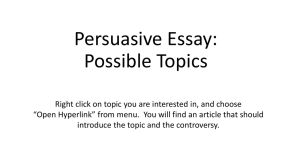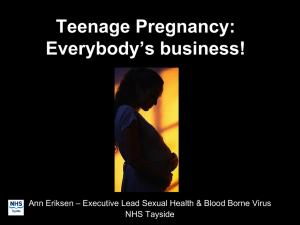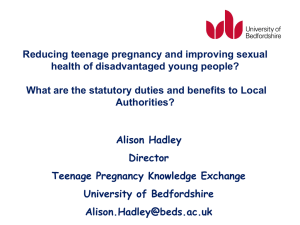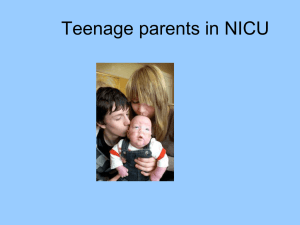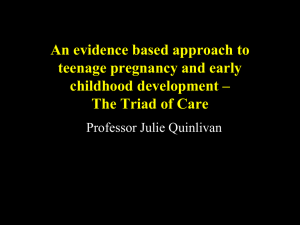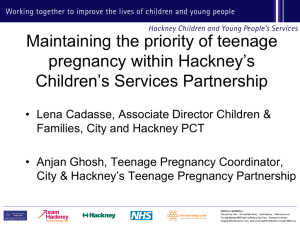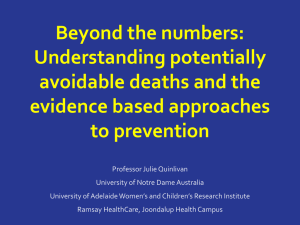the education of teenage mothers in new zealand
advertisement
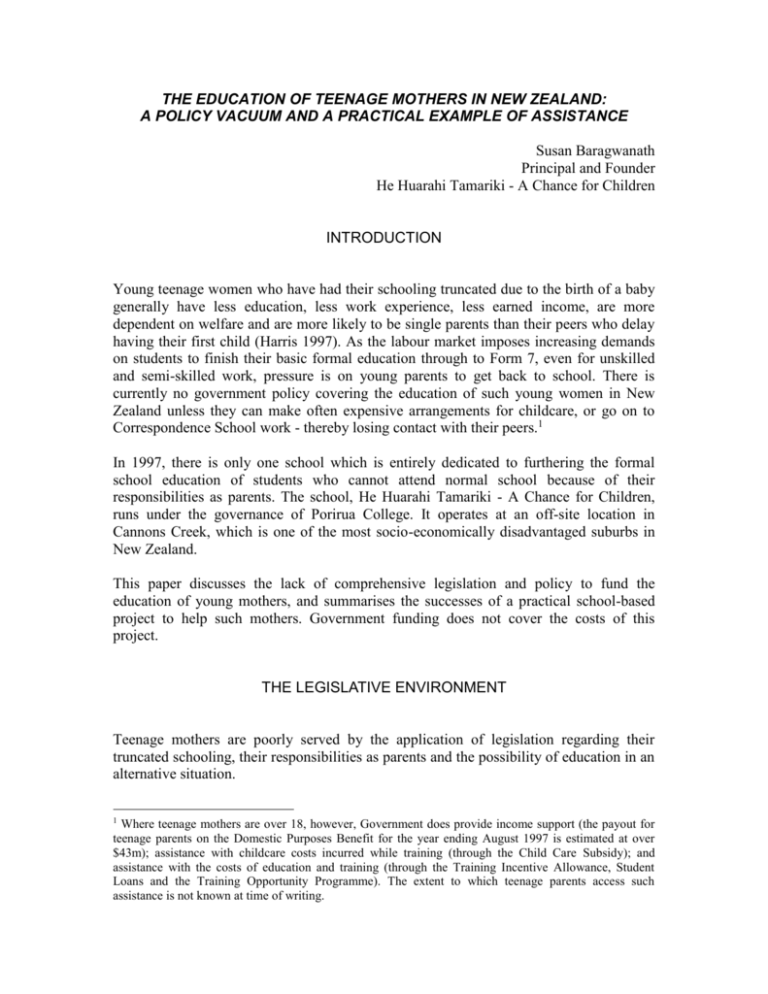
THE EDUCATION OF TEENAGE MOTHERS IN NEW ZEALAND: A POLICY VACUUM AND A PRACTICAL EXAMPLE OF ASSISTANCE Susan Baragwanath Principal and Founder He Huarahi Tamariki - A Chance for Children INTRODUCTION Young teenage women who have had their schooling truncated due to the birth of a baby generally have less education, less work experience, less earned income, are more dependent on welfare and are more likely to be single parents than their peers who delay having their first child (Harris 1997). As the labour market imposes increasing demands on students to finish their basic formal education through to Form 7, even for unskilled and semi-skilled work, pressure is on young parents to get back to school. There is currently no government policy covering the education of such young women in New Zealand unless they can make often expensive arrangements for childcare, or go on to Correspondence School work - thereby losing contact with their peers.1 In 1997, there is only one school which is entirely dedicated to furthering the formal school education of students who cannot attend normal school because of their responsibilities as parents. The school, He Huarahi Tamariki - A Chance for Children, runs under the governance of Porirua College. It operates at an off-site location in Cannons Creek, which is one of the most socio-economically disadvantaged suburbs in New Zealand. This paper discusses the lack of comprehensive legislation and policy to fund the education of young mothers, and summarises the successes of a practical school-based project to help such mothers. Government funding does not cover the costs of this project. THE LEGISLATIVE ENVIRONMENT Teenage mothers are poorly served by the application of legislation regarding their truncated schooling, their responsibilities as parents and the possibility of education in an alternative situation. 1 Where teenage mothers are over 18, however, Government does provide income support (the payout for teenage parents on the Domestic Purposes Benefit for the year ending August 1997 is estimated at over $43m); assistance with childcare costs incurred while training (through the Child Care Subsidy); and assistance with the costs of education and training (through the Training Incentive Allowance, Student Loans and the Training Opportunity Programme). The extent to which teenage parents access such assistance is not known at time of writing. There is the issue of age. Section 3 of the Education Act 1989 entitles every person to "free enrolment and free education at any state school during the period beginning on the person's 5th birthday and ending on the 1st day of January after the person's 19th birthday." What if the education of a young person has been interrupted by an unplanned pregnancy followed by the birth of a baby? It might take up to two years for the student to adjust to their new responsibilities and then want to get back into the classroom to carry on her education. While many schools may not actively discourage teenage mothers as students, it appears that many may not actively encourage them either. Active encouragement would require providing for their special needs. Yet Section 8 of the Education Act 1989 provides that "people who have special educational needs (whether because of disability or otherwise) have the same rights to enrol and receive education at state schools as people who do not". Special education is defined as "education for children who, because of a physical or mental handicap or of some educational difficulty, require educational treatment beyond that normally obtained in an ordinary class in school providing... secondary, or continuing education".2 On the one hand, secondary schools are in a difficult position. Section 44 makes it unlawful for any person who supplies services to the public or a section of the public to fail to provide any person with those services. Under the law, the school can and must provide for the mother. Usually however, the school cannot provide for her child and it is unreasonable to expect that a school should allow a student to bring her baby into the classroom. On the other hand, however, it is clear that a student who has a baby and has her schooling interrupted usually needs assistance to catch up with lost time. Often it becomes all too hard and she finds it easier just to drop out. Young mothers suffer the educational difficulties that, first because of their pregnancy and then because of the need to care for their child, mean they cannot practically be accommodated in a conventional class. Moreover, by the very nature of their ages, backgrounds and educational competence, it is unrealistic for any school to expect a group of such students to be staffed at the ratio of one teacher for twenty students in regular classroom situations unless they have very strong and consistent family support. Students who are parents have need of educational treatment beyond that normally obtained in an ordinary class. The Education and Science Select Committee (1995) reported to Parliament its findings on their inquiry into Children in Education Who Were at Risk through Truancy and Behavioural Problems. The committee recommended alternative education for students who had opted out of school for a variety of reasons. The Committee's preference was to keep the students within the school environment but, in certain circumstances, off campus provision might be necessary (Education and Science Select Committee 1995). Where there is an area of high incidence of teenage mothers who are known to have dropped out 2 Section 2 of the Education Act 1964. of their school, it is not unreasonable to make provision for an alternative educational arrangement. Furthermore, it might be considered that failure to make such alternative provision contravenes Sections 21(1)(a) and 21(1)(1) of the Human Rights Act 1993. These sections state that one of the prohibited grounds of discrimination is sex, including pregnancy and childbirth (21(1)(a)), and family status (21(1)(1)), which includes having the responsibility for care of children. The Correspondence School is the only official option for a teenage mother who cannot return to her own school or is unable to make childcare arrangements with her family or friends. Secondary schools are obliged to make every effort to enrol the student with that school and usually do so. The advantages of this type of arrangement include the potential to adapt programmes to meet the individual needs of students. Travel and childcare arrangements can be accommodated as the students can fit studies around their daily routine at home. Personal support is available from tutors on the telephone. Disadvantages of distance education include the following: • A high level of self-motivation is required, at a time of new attractions such as looking after a baby (and watching the day-time soap operas on television). • Continued enrolment requires work to be completed on time. • Good written communication skills are necessary. • A study area is required. This system is of little help to the disadvantaged and functionally illiterate, for whom even filling out forms is a major challenge. As there is no national database for tracking enrolment of students, many students drop out of the education system altogether. Serving the needs of teenage parents is difficult within the confines of current legislation and policy. The additional funding needed for this special group is difficult to find if policy does not recognise them as special. TEENAGE MOTHERS IN NEW ZEALAND School-aged mothers are at a critical stage of their own development into adult society. A baby born under such circumstances is at risk of developmental difficulties because of the mother's inadequate parenting skills (Badger 1985). There is also evidence to suggest that some teenage mothers may have unrealistic expectations about their child's development, hold more punitive child rearing attitudes and are less verbal when interacting with their babies (Furstenburg et al. 1987). New Zealand has the second highest rate of teenage births in the developed world with 35 births per 1,000 teenage girls. This compares with the average rate across the European Union of 15 births per 1,000 (United Nations Population Division 1994). Disadvantaged youths often feel they have little to lose by having a baby before they have finished their schooling. Unless they are offered an opportunity to complete their education such young women are likely to suffer irrevocable loss of basic education, with permanent adverse effects upon their child(ren), their family and themselves. They are the hardest of the at-risk students to reach in the community. Consequences are far more serious in poorer communities than they are in affluent ones (Furstenburg et al. 1987). Australian research indicates that many teenage girls who become pregnant assume that they will be unwelcome at school and appear to drop out without being aware of their educational options or the support that is available (New South Wales Department of School Education 1996). In New Zealand, a student in Southland was expelled from school in 1992 because she was carrying a child and was under 16. The reason given to the parents was that she was a poor example to other students (Southland Times 1992). The prospect of adverse reaction is typical and leads to the student leaving school when her pregnancy becomes apparent. The only effective practical means of averting the loss of such young women and their children from a real participation in society is to bring both mother and child back to school, as practiced in many US states such as Wisconsin, Maryland and Illinois. Young mothers do not wish to be parted from their children. Access to and the cost of crèche facilities is prohibitive for many disadvantaged families. Teenage, school-aged mothers are treated by the educational system as though they have no parental responsibility. Yet the Coalition Agreement (1996) states: We believe that education is the single most important investment we can make in New Zealand's future and as a priority see the focus on early childhood education, the formative years and the compulsory education sector, generally. Education and training should be seen as a lifelong exercise for New Zealanders. THE INDICATIVE SURVEY ON THE EDUCATION OF SCHOOL-AGE MOTHERS A recent indicative survey (Baragwanath 1996) on the continued or truncated schooling of teenage parents aged 16 years or under (involving nearly 40% of all girls in New Zealand secondary schools) found that: 1. Schools in the lowest socio-economic areas have the bulk of teenage mothers (86%). 2. Only 9% of mothers aged less that 16 years returned to their schools after the birth of their babies. 3. There was no consensus among the 99 respondent schools regarding who was responsible for the on-going education of school-age mothers. 4. Almost all schools considered prevention of an unplanned pregnancy as a major objective in their delivery of the health curriculum. 5. Just under half of the respondents indicated that options regarding an unplanned pregnancy were not widely known to the students. 6. Childcare was said to be available for 17% of schools (10% on site) and 15% indicated there was a comprehensive health service of some kind. 7. Only two of the 99 schools who returned surveys indicated they had a written Policy on pregnancy responding to the needs of teenage parents. RESPONDING TO THE NEEDS OF TEENAGE PARENTS: HE HUARAHI TAMARIKI- A PRACTICAL MODEL If schools do not establish special classes, centres or units for teenage parents (as the fathers may also have dropped out of school), the continuing educational needs of these young people are unable to be met. The statistics indicate that there have been over 27,000 such mothers since 1990. I am not suggesting that this equates to 4,500 teenage mothers per annum in educational need (as some will have their needs met by mainstream schools and the Correspondence School). However, there is likely to be some considerable gap in meeting need. In 1997 there is only one secondary school in New Zealand which has a dedicated class for teenage parents - with a roll averaging around 30.3 Porirua College (which has tackled the problem of the truncated education of teenage parents head on) began an initiative in November 1994 which has led to setting up a special off-site "school-within-a-school" for teenage parents. He Huarahi Tamariki: A Chance for Children was based on 56 working models in the United States.4 Students in this school are given a second chance at education but many of those enrolled did not have a first chance for reasons which may never have been known to the educational authorities. These are young people who are not ready or not able to follow tertiary programmes due to their lack of basic education. This school is characterised by an informal atmosphere, caring staff, programme flexibility, interpersonal support, and individual attention. Breakfast and a daily hot lunch, made by the students under supervision, are provided. Students have taken the lead in class organisation, keeping rosters, attendance monitoring and bookkeeping. 3 He Huarahi Tamariki - A Chance for Children school for teenage parents and their children is located in the Fanau Centre, Canons Creek, Porirua. Under the governance of Porirua College, Box 53-023, Canons Creek. 4 The founder was the recipient of the 1994 New Zealand Eisenhower Fellowship which enabled to her to spend three months in the United States visiting educational institutions for students at-risk. The parents' children are cared for in a Fanau community childcare facility next door. There is compelling evidence that, by educating the parent, the children have much more chance of success in their own lives (Education and Science Select Committee 1995, Badger 1985, Furstenburg et al. 1987). The parents' programme includes the Essential Learning Areas,5 and parenting and childcare skills, in addition to some core subjects leading to School Certificate and beyond. He Huarahi Tamariki is a working model of alternative education for students who have been unable to continue their studies in the mainstream school due to the fact that they are parents. It is a straightforward and practical answer. The funding of this operation on an annual basis is approximately $77,000 plus the cost of the Assistant. The Ministry of Education provides for $67,000. The salary for the Assistant is covered by the Crime Prevention Unit. This funding does not recognise that these students are parents (with associated impediments to being in school) and many have learning gaps. The shortfall of $10,000 (which is the cost of feeding the parents and the children and transport to and from the school) has to be raised elsewhere. This "school-within-a-school" is able to operate because of the support of the local community, the Crime Prevention Unit through the Porirua City Council Safer Cities Trust and charitable institutions. THE SUCCESS OF HE HUARAHI TAMARIKI One third of the students enrolled in He Huarahi Tamariki are taking one or two subjects for School Certificate. These students have an attendance rate of 80% or more. These are mainly students who have had the basic education which enables them to follow such courses. The other two thirds of the students have such large gaps in their education (bearing in mind that the reading age of the class ranges from 6-16 years), or are so functionally illiterate that they are unable to follow work at their age level. (These problems are not the result of having a child.) Individual programmes are worked out in consultation with the student and are currently mainly based on computer skills and computer programmes. All students on entry to He Huarahi Tamariki must take a pre-test on their goals and expectations. A post-test is taken at the end of the year to enable to student to see how far they have come. The day-to-day activities are meticulously kept in a class log. The log opens with the first person who arrives in the morning and is closed by the last to leave in the afternoon. A student is delegated to record everything that happens of significance during the day. Students also keep an individual log of their weekly achievements, their goals becoming more focused as the year advances. 5 The New Zealand Curriculum specifies seven essential learning areas which describe in broad terms the knowledge and understanding which all students need to acquire. They are: Health and Physical Wellbeing, the Arts, Social Sciences, ! Technology, Science, Mathematics, and Language and Languages. The organisation of He Huarahi Tamariki on a daily basis has been taken over by the Student Representatives. In 1996 they organised and elected a Committee. He Huarahi Tamariki has a President, Secretary, Treasurer and Senior Student. The daily chores are allocated every Monday, shopping lists are written for the week's food for parents and children, the shopping is done and the cooking programme is organised. Guests are invited every Wednesday when students prepare and serve a hot lunch. Courses in Food Handling and Food Preparation have been offered by the local Whitireia Polytechnic which yielded the first Unit Standards for many of the students. Supplementary courses have included bread making and yeast baking. The students of He Huarahi Tamariki have become empowered to the extent that they have taken" ownership" of their own education. They arrange trips and activities (which have included a visit to A Midsummer Night's Dream put on by the Royal Shakespeare Company, visiting Parliament and exhibitions in Wellington) and have taken the initiative over Drivers Licenses and a Ten Pin Bowling Tournament. Students participate in activities in the Fanau Centre which gives them access to community services and organisations. A number of the students are concurrently involved with the HIPPY6 programme (for those with children aged from three to six years) and with Parents As First Teachers. The latest student-driven initiative has been designing and organising a school uniform. In order to get their uniforms, the students had to make a representation to the Board of Trustees, and pay for the uniforms with funds which would otherwise have been used to take them on a school trip to Rotorua. Not everything is straightforward in the running of a "school-within-a-school". Students have many individual problems which have an impact on their learning. Some households run out of food, individuals have required hospitalisation, some are in violent relationships and not infrequently when the young woman has been alienated from her family, she becomes depressed and cannot concentrate. These problems are addressed the best they can with the assistance of local organisations (Community Law, Citizens Advice, Women's Refuge, Family Planning, etc.). However, events can overcome the student and she or he drops out or stays away from He Huarahi Tamariki for periods of time. The school endeavours to stay in touch by phone calls or by home visiting. Some of the students of He Huarahi Tamariki have said this about their continuing education: "This school is cool. We make it fun." "We have learned to become friends and to rely on each other. " "I am happy to be back learning and I don't feel pressured" "If I didn't have the school I would not have anyone down here". "It is very good to be given a second chance to get back to school work. It is also good for our kids". (a teenage father) "My future looks a lot brighter since I have been here learning". 6 The Home Instruction Programme for Preschool Youngsters (which is delivered out of the Fanau Centre, Cannons Creek) DIFFICULTIES FOR HE HUARAHI TAMARIKI STUDENTS The students come up against difficulties in combining "distance" and "face-to-face" education (which some of the students would like to do), because they are ostensibly enrolled at a school (Porirua College). Government policy treats students of He Huarahi Tamariki as if they are : regular students. Hence they only have access to a maximum of two subjects which are not taught at their school (despite the fact that they are not studying there). This restricts students of He Huarahi Tamariki to distance education in the subjects of Accounting, French, Human Biology and Classical Studies. They may have access to remedial subjects and pregnancy and childcare courses, but the maximum of two courses always applies. As mentioned, there is no policy provision at all for the special educational needs of teenage parents, which are beyond those normally provided for in an ordinary class. CONCLUSION . Four years of secondary education may avoid forty years on a government benefit and save millions of welfare dollars. If schools are not able to establish special classes, centres or units for teenage parents, the continuing educational needs of these young people are unable to be met. The statistics indicate that there have been over 27,000 such mothers since 1990. Some will have finished their basic formal education but the majority have not. Yet, in 1997, there is only one secondary school in New Zealand, Porirua College, which has a dedicated class. But for the existence of He Huarahi Tamariki, a number of young parents would be out of the education system. The need for policy to encompass students such as these has been clearly identified. Alternative systems of education, if properly monitored and evaluated can and do work. Without schooling the existing pattern of helplessness and hopelessness will be reinforced with the prospect that this cycle will continue. The problem will intensify until a future government is prepared to face and deal with it. REFERENCES Badger, E. (1985) "Teenage mothers and their infants" Clinics in Perinatology, 12(2):291-406. Baragwanath, S. (1996) School Age Mums: What About Their Education? Porirua College and Massey University Research Affiliateship Scheme Report No 9, Palmerston North. Coalition Agreement (1996) "Statement of General Direction Policy Area: Education" NZ Government, Wellington. Education and Science Select Committee (1995) Report of the Education and Science Select Committee, Inquiry into Children at Risk through Truancy and Behavioural Problems, NZ House of Representatives, Wellington Furstenburg, F., P. Brooks-Gunn and S.P. Morgan (1987) "Adolescent Mothers in Later Life" Cambridge University Press, United States of America. Harris, Kathleen Mullan (1997) "Teen Mothers and the Revolving Welfare Door" Temple University Press, Philadelphia. New South Wales Department of School Education (1996) "Young Mothers in Education: Materials to Assist Schools in Their Support of Young Pregnant Women and Young Mothers" Sydney. Southland Times (1992) 3 April, Invercargill. United Nations Population Division (1994) World Population Prospects: The 1994 Revision
